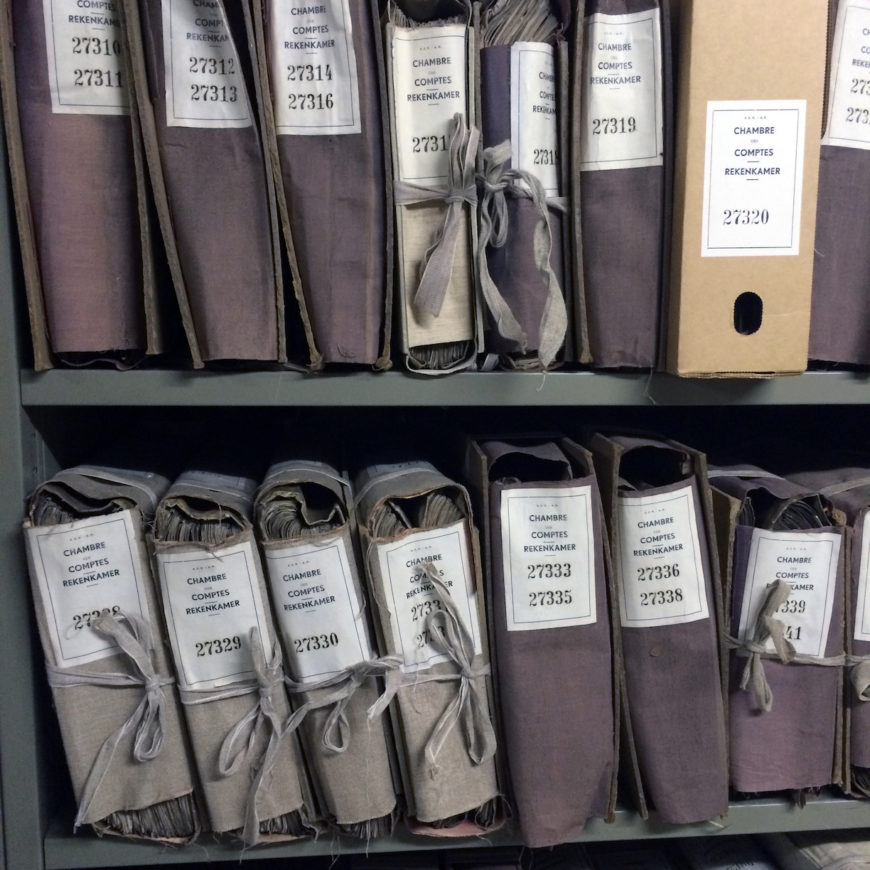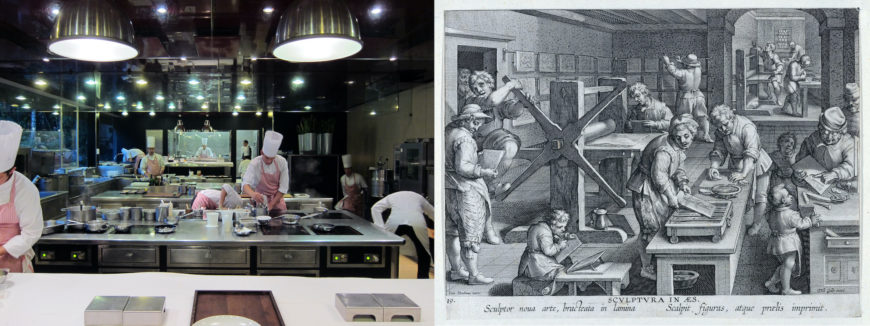
Left: commercial kitchen (photo: Kitchen, CC BY-NC 2.0); right: Jan Collaert I, after Jan van der Straet, called Stradanus, New Inventions of Modern Times, The Invention of Copper engraving, plate 19, c. 1600, 27 x 20 cm (The Metropolitan Museum of Art)
The kitchen metaphor
We may think of an individually named artist as the lone maker of a work of art, but workshop assistants played a vital part in artistic production in fifteenth-century northern Europe. The artistic workshop operated a lot like today’s fine dining restaurant kitchen. The executive chef oversees the kitchen and hierarchically organizes the space depending on task and skill level. Even though the executive chef designed the restaurant’s theme and the menu, his/her hand played little part in actually cooking each dish during service. For instance, the executive chef trains the staff and coordinates responsibilities to the chef de cuisine or sous chef. The individual stations in the kitchen are set up according to specializations with clearly defined tasks. the saucer makes sauces; the poissonnier works solely on fish and seafood; the garde manager provides elements to complete the dish, among other tasks; and the pastry concentrates on the desserts. If there’s an especially high-end client, the executive chef might step in for quality assurance. But on a typical night of service, multiple hands touch the dish before it leaves the kitchen. Above all, restaurant patrons know that the executive chef stands as the mastermind from ideation to execution.
In this analogy, substitute executive chef for a master workshop, and dish for a work of art, and the inner workings of the artistic workshop reveal a collaborative enterprise. The idea of an artist without assistants stems from nineteenth-century ideas of originality (imagine a solitary artist in the studio as the sole creator of a work of art from start to finish). Our modern idea of individual innovation doesn’t reflect the conditions of the fifteenth-century artistic workshop, in which artists were highly skilled artisans or craftsmen that worked together.
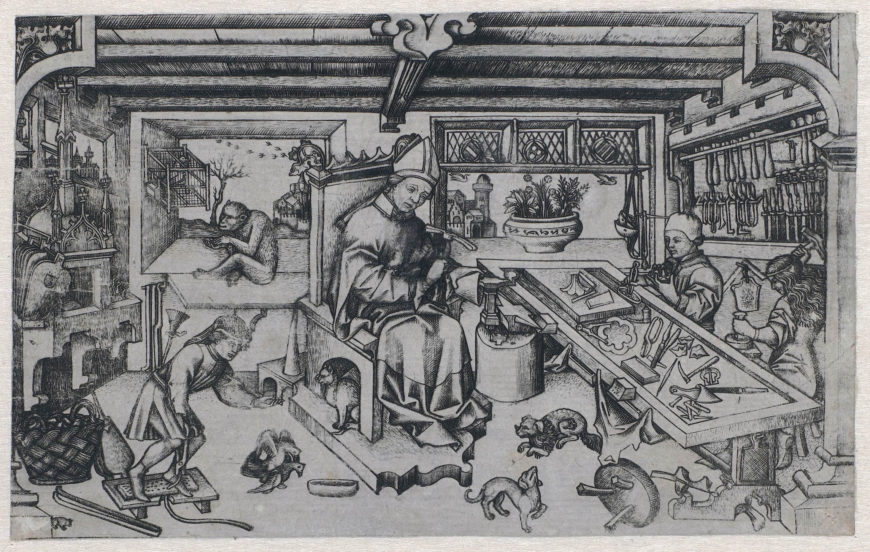
St. Eloy (also called St. Eligius) The patron saint of goldsmiths and metalworkers, is shown here in his workshop with three assistants. The workshop space is filled with the tools of his trade, including the furnace to heat metal, molds, hammers, and pliers. Master of Balaam, St. Eloy in his workshop, 1440–60, engraving, 11.5 × 18.5 cm (Rijksmuseum)
Cooperative learning and collaboration
Late-medieval and early modern northern European workshops operated on the principles of cooperative learning and collaboration. Like the workshop in Italian Renaissance art, late-medieval and early modern northern European workshops also operated on the principles of cooperative learning and collaboration.
Both large and small workshops functioned hierarchically with centralized management and divided labor based on technical expertise and training experience. The head of the workshop was called a master. In Antwerp around the year 1500, it could take 11 years to become a master. Masters were also allowed to sell their works of art at the guild’s booth by the Antwerp Cathedral.
The typical workshop master employed assistants as apprentices or journeymen. An apprentice is like a master-in-training. To return to the kitchen metaphor, a stage or internship is the cornerstone of chef training: young chefs study under executive chefs to gain practical experience in the kitchen before advancing to the next career stage. In the workshop, an apprentice assisted the master closely to learn the trade. In contrast, journeymen were itinerant artists. They required less hands-on training than assistants, and could travel far from their home city in search for temporary work and were often brought in for specific commissions. Not every master had assistants, but on average, the more costly a commission, the more likely the master had extra sets of hands.
Knowledge of how these assistants were trained remains highly speculative, yet it is clear that training depended on the ability to emulate and repeat the master’s work. In the fifteenth century, workshop masters required a cohesive style: collaborators and assistants had to imitate the master.
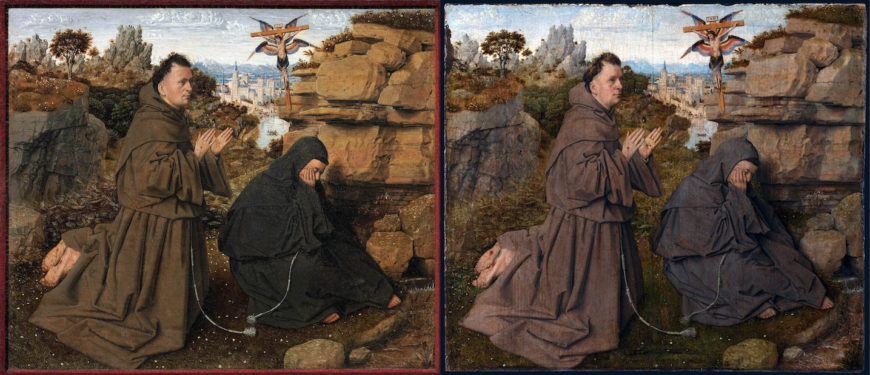
Two versions of Jan van Eyck, St. Francis Receiving the Stigmata, 1430-1432. Left: oil on vellum on panel, 12.7 × 14.6 cm (Philadelphia Museum of Art); right: oil on panel, 29.3 × 33.4 cm (Sabauda Gallery, Turin)
Two nearly identical panels of St. Francis Receiving the Stigmata from the Jan van Eyck workshop in Philadelphia and Turin give some context to training. These two panels of the same subject share a remarkably similar style but differ in size and support. Dendrochronology reveals that both wooden panels stem from the same workshop: most likely the Philadelphia panel (left) is a workshop replica of the original Turin (right). In spite of the paucity of archival evidence on the inner workings of Jan van Eyck’s workshop, these two panels demonstrate that van Eyck certainly had multiple collaborators.
![Campin, Merode Altarpiece [center Annunciation], MET; Jacques Daret or Campin workshop (?), Annunciation, Musée des Beaux-Arts, Brussels; Rogier Annunciation triptych [center], Louvre](https://smarthistory.org/wp-content/uploads/2021/07/campin-cf.-copy-870x275.jpg)
The shared resemblance between these three Annunciation paintings has intrigued art historians for decades. Campin’s workshop made the Merode Altarpiece (left) and possibly the Annunciation panel in Brussels (center), which has also been attributed to Campin’s pupil, Jacques Daret. Rather than focusing on “who” made which panel first, it is helpful to think of these similarities as part of the workshop method of training artists. Left: Robert Campin’s Workshop, detail of the Annunciation, Annunciation Triptych (Merode Altarpiece), 1425–28, tempera and oil on panel (The Metropolitan Museum of Art); Jacques Daret or Campin workshop (?), The Annunciation, 1415–25, oil on oak, 63.7 x 61 cm (Musée des Beaux-Arts, Brussels); Rogier van der Weyden, detail of the Annunciation, Annunciation triptych, c. 1435, oil on panel, 86 x 93 cm (Louvre)
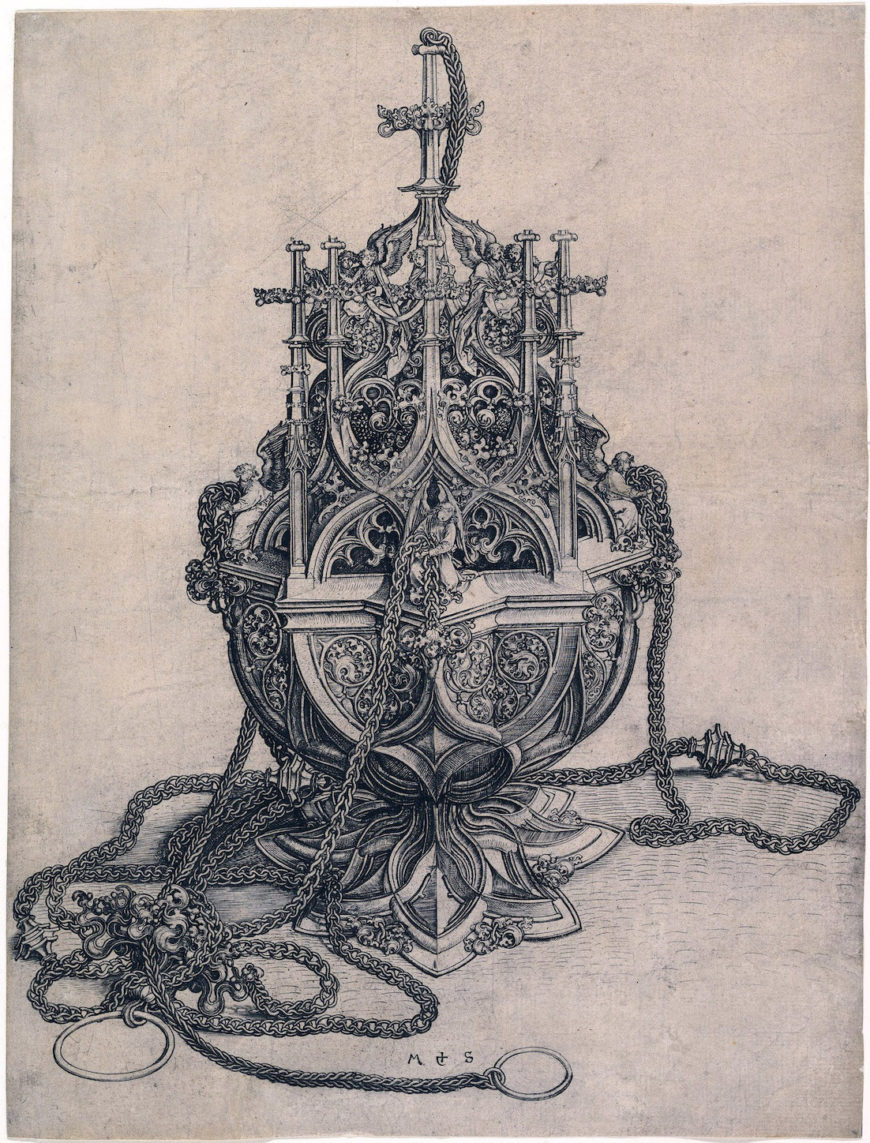
Martin Schongauer, The Censer, c. 1435–91, engraving, 48.9 x 36.3 cm (The Metropolitan Museum of Art)
Training was often done within families, where young artisans had easy access to learning and tools of the trade. In particular, goldsmithing and metalworking—gouging fine lines into a metal—served as a gateway to early printmaking. For instance, the highly skilled early engraver, Martin Schongauer clearly translated his familial training in goldsmithing to the metal plate. Albrecht Dürer began his training as a draftsman in his father’s goldsmith workshop as well. Dürer’s mother, Barbara, and wife, Agnes, are recorded selling his prints at local fairs and abroad.
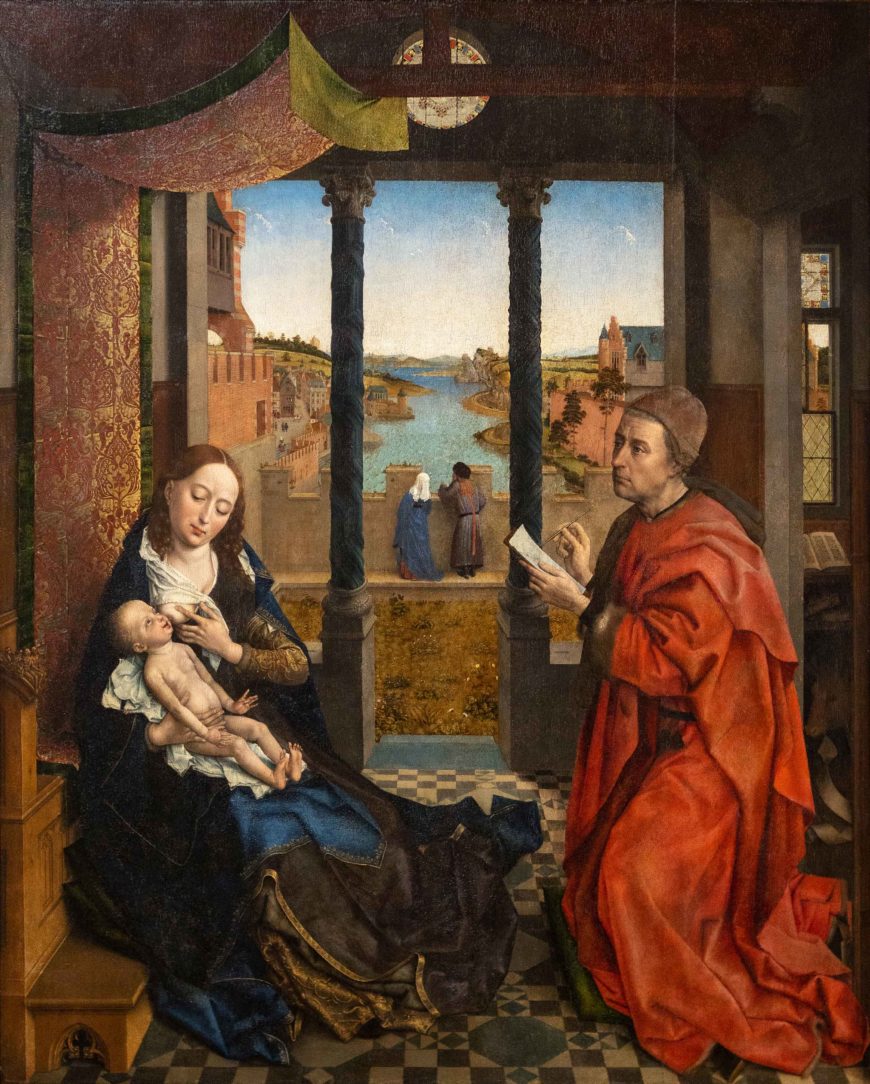
Rogier van der Weyden, St. Luke Drawing the Virgin, c. 1435–40, oil and temper on panel, 137.5 x 110.8 cm (photo: Steven Zucker, CC BY-NC-SA 2.0; Museum of Fine Arts, Boston)
Guilds and the rise of the ‘artist’
Masters in later medieval urban centers belonged to guilds. Cities like Bruges and Antwerp, which boasted robust market economies, maintained several guilds according to occupation or a specific trade, such as painting, carpentry, or goldsmithing. Guilds served a variety of practical functions: they offered education and training, regulation, conflict management, as well as professional solidarity.
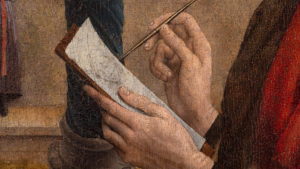
Drawing with silverpoint (detail), Rogier van der Weyden, St. Luke Drawing the Virgin, c. 1435–40, oil and temper on panel, 137.5 x 110.8 cm (photo: Steven Zucker, CC BY-NC-SA 2.0; Museum of Fine Arts, Boston)
The Guild of St. Luke was the most common name of painters guilds, although in many cities the Guild of St. Luke also encompassed sculptors and other arts. The name derives from St. Luke the Evangelist, the patron saint of artists, who according to legend, painted an icon of the Virgin. The subject of St. Luke Painting the Virgin became a popular way for artists to promote their craft, aligning their skill with the patron saint of the arts. Painters creatively reinvented this image, such as in Rogier’s rendition of St. Luke Drawing the Virgin, with St. Luke using silverpoint. In Jan Gossaert’s later Saint Luke’s Painting of the Madonna, St. Luke’s hand is guided by the angel during a vision.
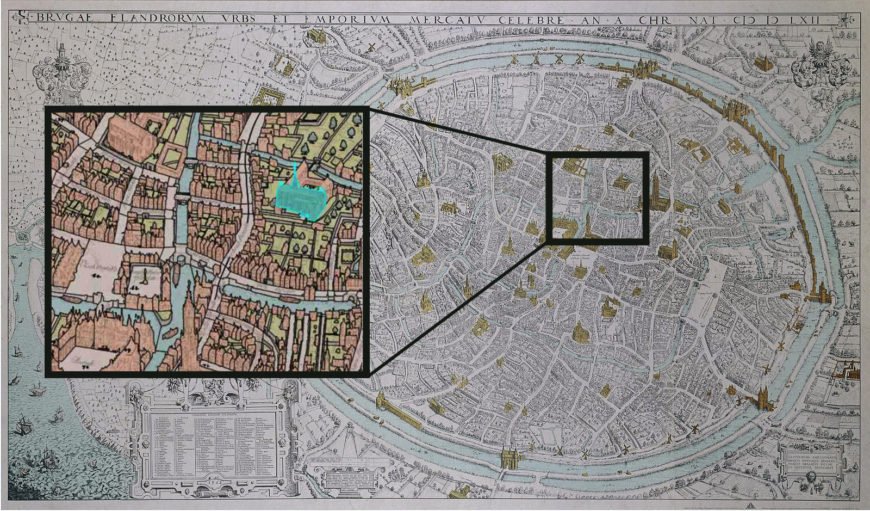
Gerard was a member of the painters’ guild, located in the center of Bruges. Underlying map: Marcus Gerard, Map of Bruges, 1562, etching on 10 plates, 100 x 177 cm (Groeningemuseum); inset map: from MAGIS Brugge
Guilds became one of the foundational aspects of art-making in the late-medieval city. On Marcus Gerard’s sixteenth-century bird’s eye view of Bruges, the Guild of St. Luke (in Dutch, Sint-Lucasgilde) is located in the center of town, near the cathedral, town hall, and marketplace. The guild’s prominent presence in the urban fabric of Bruges the vital role of painting in devotional visual culture. As a leading artistic center in northern Europe, Bruges was home to some of the most well-known painters in the fifteenth century, including Jan van Eyck, Petrus Christus, and Hans Memling, among others. In Bruges, the painters’ guild applied to all ‘painting’ independent of the type of surface one painted on—wood, cloth, walls, houses, glass, etc. Painters were required to enroll in the guild, in which local citizenship was a prerequisite (citizenship served as a protect against outside competition).
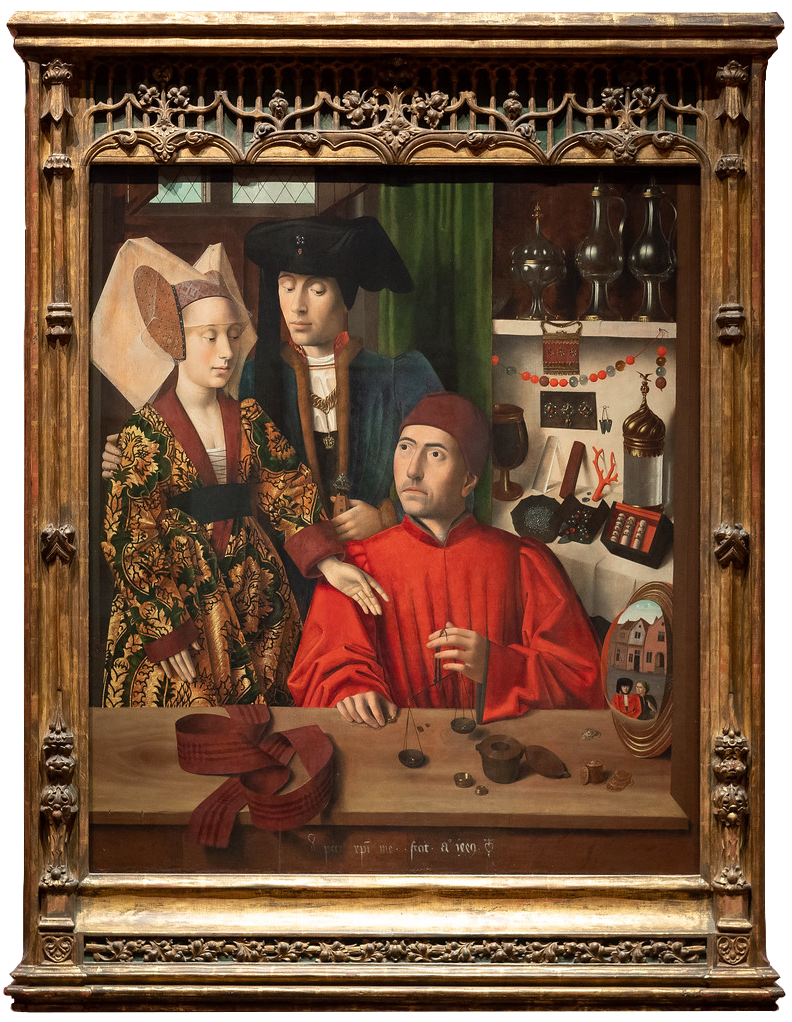
Petrus Christus, A Goldsmith in his Shop, 1449, oil on oak panel, 100.1 x 85.8 cm (The Metropolitan Museum of Art; photo: Steven Zucker, CC BY-NC-SA 2.0)
Northern European cities in the fifteenth century underwent a rapid change in the way guild artisans interacted directly with their clientele, who became increasingly able to afford art. Petrus Christus’s painting, A Goldsmith in his workshop, points to this rising status of the artist guild in the late-medieval city. Christus the Goldsmith Craftsman in the Center of the City: The Convex Mirror on the Far Right of the Workshop Bench Places Two Men on the City Street. In so doing, the painting links the interior space of the goldsmith workshop—filled with objects of the goldsmith trade—to the open, urban space of commerce.
The workshop in documentary sources
In the fifteenth century, artists not only rarely signed their work, but the labor of collaborators also left little documentary trace. The absence of names makes it challenging to determine the exact makeup of workshops.
Art historians use the range of documentation to reconstruct the lives of individual artists: receipts, letters or correspondence, inventories, guild membership books, housing and tax records, as well as citizens’ registers (eg the Poortenbucher in Bruges), and so forth. Not every artist is listed consistently across sources. Hans Memling, for instance, is never mentioned as a member of the painters’ guild in Bruges, but he is recorded on the guild’s memorial list.
Jan van Eyck is listed in several types of documents related to his work at the courts of Philip the Good and John of Bavaria. His name notably takes many forms in account books as “Iohannes pointre,” “Jan dem maelre,” (‘Jan the painter’) and “Jehan de Heick” (‘Jan van Eyck’), among others. His status as a court painter also meant that he did not have to register in the painters’ guild upon his arrival in Bruges. It is worth noting that his frequently listed solo name on documentary sources does not imply that he worked without apprentices. Workshop assistants, as well as journeymen, often remain unnamed in account books, and thus, stay anonymous to us today.
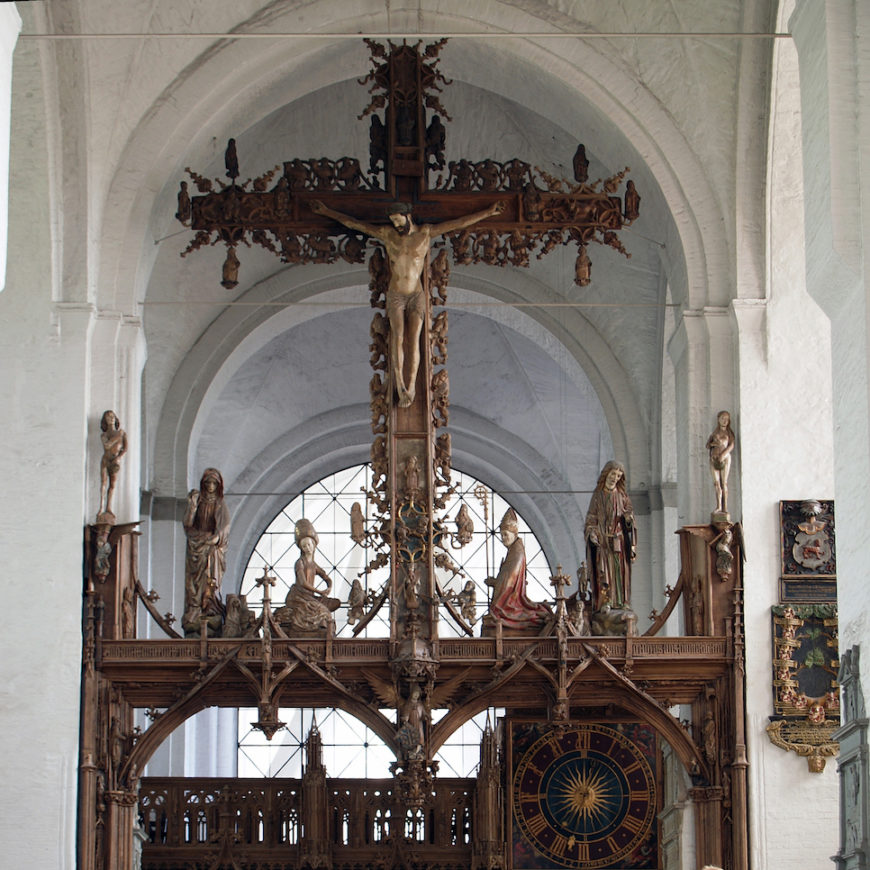
Bernt Notke, Triumphal Cross, Lübeck Cathedral, consecrated in 1477, polychromed oak (photo: Arnoldius, CC BY-SA 3.0)
Modern conservation has some exciting discoveries in revealed workshop assistants. In 1972, for example, the carved wooden sculptures from Bernt Notke’s Triumphal Cross from Lübeck Cathedral’s rood screen were opened as part of the city’s protracted postwar conservation projects. Conservators found a piece of parchment glued to the inside of the wooden plank that sealed the figure of St. John, bearing an inscription in Low German that says:
In this year of grace 1472, master Bernt Notke then made this piece of work with the help of his journeymen, the first Eggert Svarte by name, carver, Lucas Meer, finisher, Bernt Scharpeselle, finisher Ilges, finisher [and] Hartich Stender, painter. Pray [to] God That is Their souls They may find grace before God. [1]
In this rare finding, a document violates the names of individual artists and their specific roles in the making of the work of art. Master (meister) Notke employed five journeymen (gesellen), and notably, three preparers (berender) for polychromy, which the need to prepare the expansive surface area of the oaken figures for painting.
St. George and the . . . kitchen
Let’s return to the restaurant kitchen. If you’ve watched Bravo’s Top Chef, you know that the collaborative kitchen is also a place of judgment and critique. The fifteenth-century workshop was similarly cooperative and competitive.
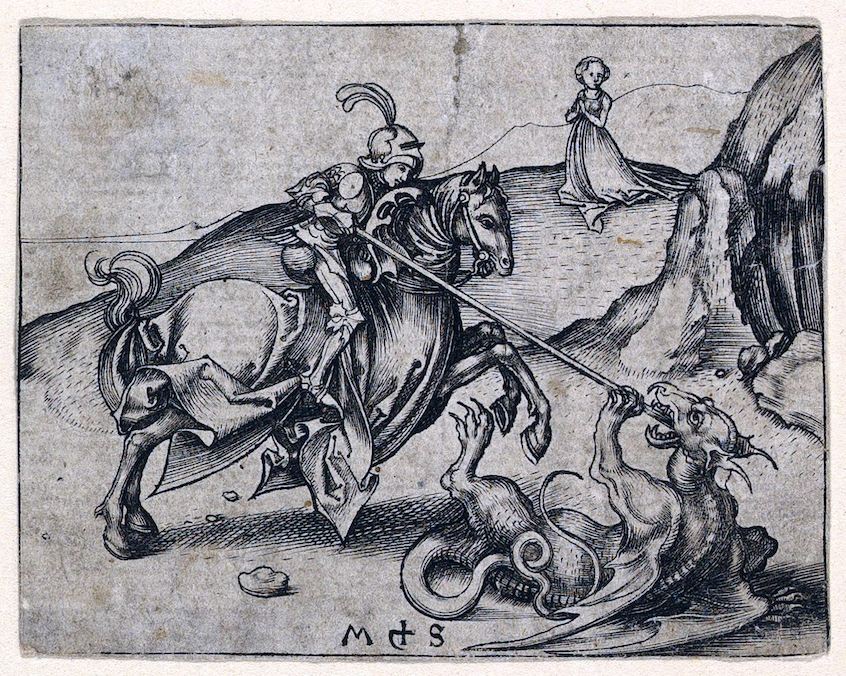
The popularity of St. George and the Dragon in prints likely served as a model for young artists to translate the subject into other media. For instance, Martin Schongauer positions St. George’s launch to pierce directly into the dragon’s mouth, readily showing artists a variation on how to violently slay the dragon. Schongauer, Saint George Slaying the Dragon, c. 1435–91, engraving, 5.7 x 7.4 cm (The Metropolitan Museum of Art)
Apprentices in some guilds had to submit a masterwork at the end of their workshop training. Guilds in Krakow, Hamburg, Lübeck, Lüneburg, and Prague assigned St. George and the Dragon as the masterpiece theme. St. George and the Dragon was a favored choice, in part because of the difficulty in representing the intense narrative and drama of St. George slaying a fighting dragon. The submitted masterpiece was then judged by guild officials, and upon completion, the apprentice could advance to a master position (so long as they met other local requirements as well). Not every apprentice earned the title of master though, and it was certainly not as expeditious as a Quickfire Challenge .
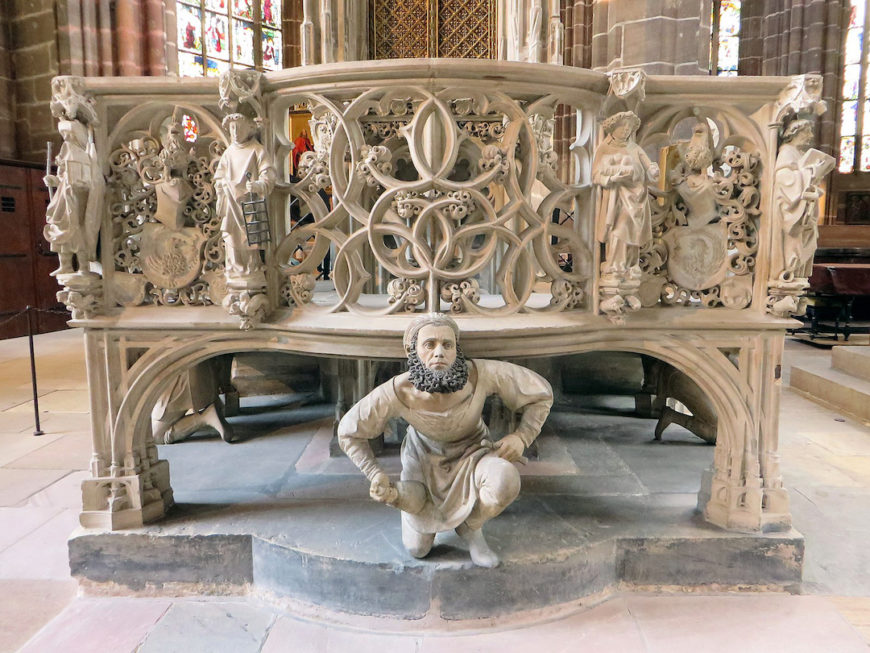
Kraft, the master stone carver and builder, holds a mallet and chisel. Adam Kraft, self-portrait at the bottom of the carved tabernacle, in St. Lawrence Church, Nuremberg, 1493–96, sandstone (Klaus Bärwinkel, CC BY-SA 4.0)
Late-medieval or early modern?
The fifteenth century witnessed a transformational rise of artistic awareness and self-fashioning. Portraiture, including self-portraiture, increasingly became a motif for artists to depict their self-consciousness about their role as image makers. In one example, Adam Kraft represents himself as a craftsman in work clothes, holding the tools of his trade. The placement of his self-portrait, moreover, serves the stone-carved buttress tabernacle in St. Lawrence Church, which he carved with his journeymen.
Kraft’s tabernacle portraits blur the boundaries of “medieval” and “early modern” art-making in the fifteenth century. On the one hand, Kraft promotes his artistic status through self-portraiture—the assertion that he made this sculpture, thereby authenticating his authorship. On the other hand, Kraft’s two journeymen are positioned alongside their master carver (only their legs are visible in the photograph above). These carved portraits reinforce the late-medieval context of the workshop training, craft, and labor: Kraft was not alone in his workshop.
The principles of the collaborative artistic workshop are revealed to us today in many forms: portraits carved in stone, text on parchment, and guilds in the urban fabric of the late-medieval city. Although we increasingly find names of individual artists assigned to works of art in the fifteenth century, the artist—or artisan—trained and operated within a collective workforce.
Notes:
[1] Low German inscription is transcribed and published in Eike Oellermann, Das Triumphkreuz von Bernt Notke im Dom zu Lübeck” Kunstchronik Monatschrift für Kunstwissenschaft 26.4 (April 1973): p. 94.
This essay has received funding from the European Union’s Horizon 2020 research and innovation program under the Marie Skłodowska-Curie grant agreement No. 840531.
Additional resources
Closer to van Eyck Project. Royal Institute for Cultural Heritage [KIK-IRPA], Brussels.
Maryan W. Ainsworth, Petrus Christus: Renaissance master of Bruges (Metropolitan Museum of Art, 1994).
Jeffrey Chipps Smith, The Northern Renaissance (Phaidon, 2004).
Elizabeth Honig, Painting and the Market in Early Modern Antwerp (Yale University Press, 1998).
Maximilaan Martens, Till-Holger Borchert, Jan Dumolyn, Johan De Smet, and Frederica Van Dam, eds., Van Eyck (Thames & Hudson, 2020).
Susie Nash, Northern Renaissance Art, Oxford History of Art Series (Cambridge University Press, 2008).
Eike Oellermann, “Das Triumphkreuz von Bernt Notke im Dom zu Lübeck” Kunstchronik Monatschrift für Kunstwissenschaft 26.4 (April 1973): pp. 93-96.
James Snyder, Northern Renaissance Art: Painting, Sculpture and the Graphic Arts from 1350 to 1575, revised by Larry Silver and Henry Luttikhuizen (Prentice Hall, 2005).
Hugo van der Velden “Defrocking St Eloy: Petrus Christus’s ‘Vocational Portrait of a Goldsmith’,” Simiolus 26, no. 4 (1998): pp. 242–76.
Elien Vernackt “MAGIS Brugge: Visualizing Marcus Gerhard’s 16th-century Map through its 21st-century Digitization,” Artl@s Bulletin 7.2 (Fall 2018): p. 26-41.

